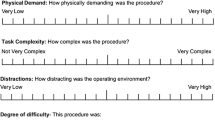Abstract
Background
Fatigue and mental workload are directly associated with high-complexity tasks. In general, difficult tasks produce a higher mental workload, leaving little opportunity to deal with new/unexpected events and increasing the likelihood of performance errors. The laparoscopic Roux-en-Y gastric bypass (LRYGB) learning curve is considered to be one of the most difficult to complete in laparoscopic surgery. We wished to validate the National Aeronautics and Space Administration Task Load Index (NASA-TLX) in LRYGB and identify factors that could provoke a higher mental workload for surgeons during the learning curve.
Methods
A single surgeon was enrolled to undertake 70 consecutive LRYGB procedures with two internal surgeons mentoring the first 35 cases. Patients were consecutive and ranked from case 35 to case 105 according to the date of the surgical procedure (“case rank”). Self-ratings of satisfaction, performance, and fatigue were measured at the end of surgery using a validated NASA-TLX questionnaire. The procedure was recorded for later viewing by two external evaluators. General data for patients and surgical variables were collected prospectively.
Results
A moderate correlation between the NASA-TLX score, BMI, operative time, and volumes of blood drainage was observed. There was no correlation between the NASA-TLX score and duration of hospital stay or time of drain removal. BMI ≥50 kg/m2, male sex, inexperienced first assistant, and type 2 diabetes mellitus were identified as independent predictive factors of a higher NASA-TLX score.
Conclusions
The NASA-TLX is a valid tool to gauge mental workload in LRYGB.
Similar content being viewed by others
References
DiDomenico A, Nussbaum MA. Interactive effects of physical and mental workload on subjective workload assessment. Int J Ind Ergonom. 2008;38:977–83.
Carswell CM, Clarke D, Seales WB. Assessing mental workload during laparoscopic surgery. Surg Innov. 2005;12:80–90.
Berger R, Smith WD, Chung YH. Performing laparoscopic surgery is significantly more stressful for the surgeon than open surgery. Surg Endosc. 2001;15(10):1204–7.
Berguer R, Smith W. An ergonomic comparison of robotic and laparoscopic technique: the influence of surgeon experience and task complexity. J Surg Res. 2006;134(1):87–92.
Hsu KE, Man FY, Gizicki RA, et al. Experienced surgeons can do more than one thing at a time: effect of distraction on performance of a simple laparoscopic and cognitive task by experienced and novice surgeons. Surg Endosc. 2008;22(1):196–201.
Sánchez-Santos R, Estévez S, Tomé C, et al. Training programs influence in the learning curve of laparoscopic gastric bypass for morbid obesity: a systematic review. Obes Surg. 2012;22(1):34–41.
Oliak D, Owens M, Schmidt HJ. Impact of fellowship training on the learning curve for laparoscopic gastric bypass. Obes Surg. 2004;14(2):197–200.
Pournaras DJ, Jafferbhoy S, Titcomb DR, et al. Three hundred laparoscopic Roux-en-Y gastric bypasses: managing the learning curve in higher risk patients. Obes Surg. 2010;20(3):290–4.
Zevin B, Aggarwal R, Grantcharov TP. Simulation-based training and learning curves in laparoscopic Roux-en-Y gastric bypass. Br J Surg. 2012;99(7):887–95.
Søvik TT, Aasheim ET, Kristinsson J, et al. Establishing laparoscopic Roux-en-Y gastric bypass: perioperative outcome and characteristics of the learning curve. Obes Surg. 2009;19(2):158–65.
Hart SG, Staveland LE. Development of NASA-TLX (Task Load Index): results of empirical and theoretical research. In: Hancock PA, Meshkati N, editors. Human mental workload. North-Holland: Elsevier; 1987. p. 139–83.
Yurko YY, Scerbo MW, Prabhu AS, et al. Higher mental workload is associated with poorer laparoscopic performance as measured by the NASA-TLX tool. Simul Healthc. 2010;5(5):267–71.
Stefanidis D, Wang F, Korndorffer Jr JR, et al. Robotic assistance improves intracorporeal suturing performance and safety in the operating room while decreasing operator workload. Surg Endosc. 2010;24(2):377–82.
Dulan G, Rege RV, Hogg DC, et al. Proficiency-based training for robotic surgery: construct validity, workload, and expert levels for nine inanimate exercises. Surg Endosc. 2012;26(6):1516–21.
Olbers T, Fagevik-Olsén M, Maleckas A, et al. Randomized clinical trial of laparoscopic Roux-en-Y gastric bypass versus laparoscopic vertical banded gastroplasty for obesity. Br J Surg. 2005;92(5):557–62.
Dindo D, Demartines N, Clavien PA. Classification of surgical complications: a new proposal with evaluation in a cohort of 6336 patients and results of a survey. Ann Surg. 2004;240(2):205–13.
Agrawal S. Impact of bariatric fellowship training on perioperative outcomes for laparoscopic Roux-en-Y gastric bypass in the first year as consultant surgeon. Obes Surg. 2011;21(12):1817–21.
Mehta RK, Agnew MJ. Influence of mental workload on muscle endurance, fatigue, and recovery during intermittent static work. Eur J Appl Physiol. 2012;112(8):2891–902.
Zheng B, Jiang X, Tien G, et al. Workload assessment of surgeons: correlation between NASA-TLX and blinks. Surg Endosc. 2012;26(10):2746–50.
Engelmann C, Schneider M, Kirschbaum C, et al. Effects of intraoperative breaks on mental and somatic operator fatigue: a randomized clinical trial. Surg Endosc. 2011;25(4):1245–50.
Martini CH, Boon M, Bevers RF, et al. Evaluation of surgical conditions during laparoscopic surgery in patients with moderate vs deep neuromuscular block. Br J Anesth. 2014;112(3):498–505.
Blobner M, Frick CG, Stäuble RB, et al. Neuromuscular blockade improves surgical conditions (NISCO). Surg Endosc. 2015;29(3):627–36.
Ballantyne GH, Svahn J, Capella RF, et al. Predictors of prolonged hospital stay following open and laparoscopic gastric bypass for morbid obesity: body mass index, length of surgery, sleep apnea, asthma, and the metabolic syndrome. Obes Surg. 2004;14(8):1042–50.
Author information
Authors and Affiliations
Corresponding author
Ethics declarations
Conflict of Interest
The authors declare that they have no competing interests.
Statement of Informed Consent
Informed consent was obtained from all individuals participants included in the study
Statement of Human and Animal Rights
All procedures performed in studies involving human participants were in accordance with the ethical standards of the institutional and/or national research committee and with the 1964 Helsinki Declaration and its later amendments or comparable ethical standards
Grant Information
The study was supported by grant from the Fundación Progreso y Salud, Consejería de Bienestar y Politicas Sociales, Junta de Andalucía (PI-0340-2013)
Rights and permissions
About this article
Cite this article
Ruiz-Rabelo, J.F., Navarro-Rodriguez, E., Di-Stasi, L.L. et al. Validation of the NASA-TLX Score in Ongoing Assessment of Mental Workload During a Laparoscopic Learning Curve in Bariatric Surgery. OBES SURG 25, 2451–2456 (2015). https://doi.org/10.1007/s11695-015-1922-1
Published:
Issue Date:
DOI: https://doi.org/10.1007/s11695-015-1922-1




